Innovation born in San Francisco triggered a hi-tech revolution that changed America and much of the world. We’re not talking here about the digital innovations from Silicon Valley. Nor the analog innovation by Philo T. Farnsworth, in a little building on Green Street in 1927, that gave birth to television. We’re talking about mechanical innovation 150 years ago that began a revolution in how people move around cities.
We’re talking cable cars.
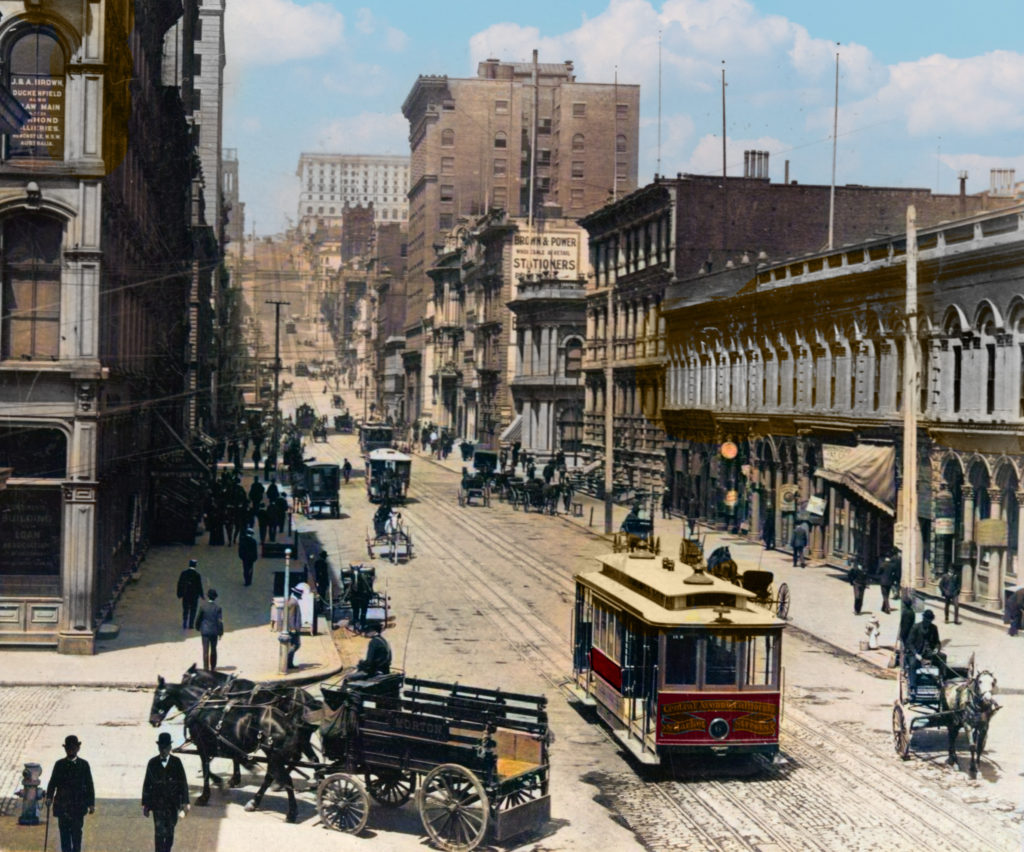
Steam transforms travel
Technology transformed America in the last third of the 19th century, and many other countries as well. Much of it was driven by an invention from Britain, way back in the year America declared its independence: 1776. That was the year of Scotsman James Watt’s seminal invention of the stationary steam engine, converting fossil fuels into energy.
Over the decades that followed, other inventors both improved steam engine technology and harnessed it for myriad new tasks previously performed by humans, animals, or nature.
By 1807, building on incremental innovations by others, American Robert Fulton launched the first practical steamboat, Clermont, on New York’s Hudson River, spawning a revolution in water transport.
In England between 1817 and 1830, George and Robert Stephenson, father and son, iteratively advanced the application of the steam engine to locomotion on rails, laying the technological tracks for an explosion in railway construction around the world that lasted almost a century. (Most of the new railroads used “Stephenson’s gauge” for the space between rails, 1,435mm or 4’8-1/2”, soon to be known as “standard gauge.”)
As with the steamboat, so with the steam locomotive, the Stephensons worked in competition with other engineers and scientists to achieve a practical application of steam to transport. Decade by decade, these advances allowed steam-powered boats and trains to get larger and more efficient, just as advances in silicon chips and miniaturization moved computers forward.
In America, continuing improvements to steam locomotion advanced the railroad age here, reaching a transcendent moment in 1869, with the completion of the first Transcontinental Railroad, which brought passengers from Back East to the shore of San Francisco Bay in Oakland, just a short ferryboat ride away.
From steam to stench
But when those early transcontinental railroad passengers, powered by steam all the way across the country, disembarked from steam-powered ferryboats on San Francisco wharves, the only transport that awaited them was horse-powered, complete with the stench and health hazard of what thousands of street horses left behind every day. The same situation existed in New York, Chicago, and cities across America and around the world (see “Hold your horses” at bottom).
Almost a century after Watt invented the steam engine, no one had yet found a practical way to harness its undeniable power for urban transport. Tiny horse-drawn railcars—horsecars—dominated urban street “mass transit” in America.
True, San Francisco’s main stem, Market Street, had inaugurated engine-powered transit in 1860, in the form of a “steam-car” that resembled a mainline railroad passenger coach, with a steam engine camouflaged by the body. But the noise, which resisted muffling, and the acrid smell scared horses and also discouraged passengers. The Market Street steam car was gone within a few years, replaced by horsecars.
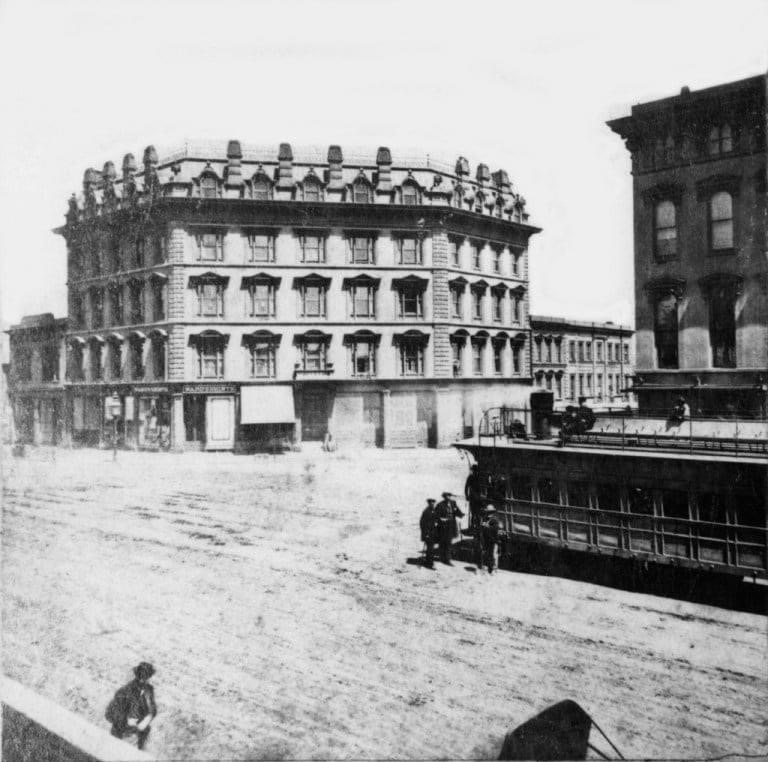
Steam-powered transit did have its place in San Francisco—where people weren’t living or working nearby. Steam locomotives and small steam “dummies” towed passenger cars across a few empty parts of San Francisco until the turn of the 20th century, but as the 1870s dawned, urban street transit vehicles powered directly by onboard steam engines remained impractical, even as ever-larger steam-driven ships and railroad locomotives proliferated around the world.
Enter Andrew Hallidie
Like James Watt, Andrew Smith Hallidie was a Scotsman and inventor. His father, Andrew Smith, had earned an early patent for wire rope (steel cable). Father and son came to California in 1853 to work gold mines in which the father had a financial interest. They didn’t play out. The father returned home but the son stayed, built numerous bridges in gold country, and started his own successful wire rope business.
Andrew Hallidie (who adopted his uncle’s surname as an adult) was very familiar with stationary steam engines. They powered a cable-hauled aerial conveyer he designed, carrying ore buckets from mines to mills in gold country.
Hallidie himself said on repeated occasions that the idea of adapting his cable ore carrier to transport people came to his mind one rainy night in San Francisco, when he witnessed horses slipping on wet pavement on a hill and being dragged to their death by the heavy railcar they were towing. Putting the cable underground, beneath the tracks, and powering it with a central stationary steam engine, could replace horses.
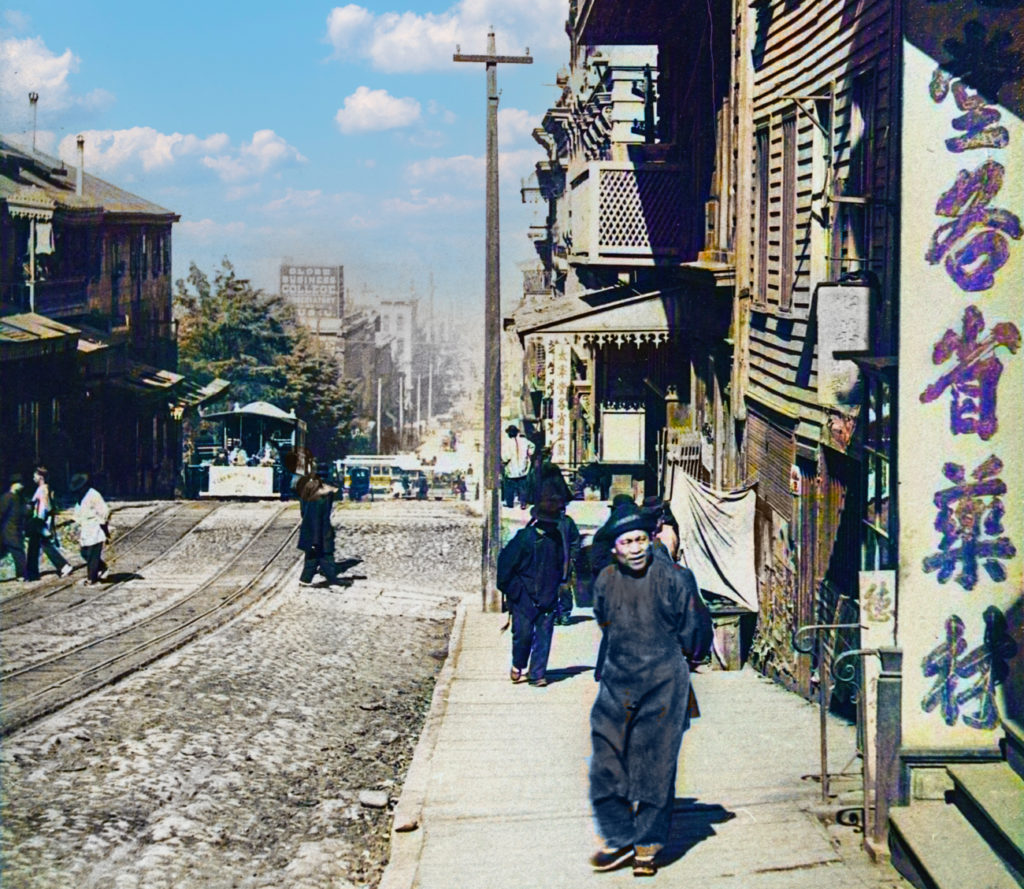
Hallidie biographer Taryn Edwards believes whether or not Hallidie actually saw horses suffer that way, his story would help position the cable system as a humane improvement in transportation, rather than strictly as a profit-making proposition. This type of beneficent origin story would be told a century later by many Silicon Valley startup founders.
In any event, Hallidie wasn’t alone in his thinking. Others were developing concepts for putting steam-engine-driven cables underground to haul passengers riding railcars. In San Francisco, an attorney named Benjamin Brooks, who speculated in rail franchises, partnered with an Army officer, Abner Doubleday, to buy a franchise from the City for a rail line on Clay Street. (Yes, that Abner Doubleday, Union Army general later falsely credited with inventing baseball, a credit he never himself claimed.)
Doubleday and Brooks hadn’t started building when the Army transferred Doubleday to Texas in 1871. They sold the franchise to Hallidie in 1872, leaving Hallidie only a year to create an operating system, or the franchise would expire—at midnight on August 1, 1873.
Hallidie hurried. He hired a German immigrant engineer named Wilhelm (William) Eppelsheimer, who designed a grip that would squeeze and release the moving underground cable reliably. Other than the grip, though, most of what Hallidie and Eppelsheimer did was to aggregate existing technologies—the underground wheels and pulleys, the steam engine, the cable, and so on. But they were the first to make it work on an actual line that carried paying passengers.
It appears Hallidie actually missed the franchise deadline. The long-assumed date of August 1 for that first run has been disproved by several contemporary newspaper accounts. The first trip didn’t happen until around 5:00am on August 2. Even then, it was a near thing. One story has it that the first gripman in cable car history, James Hewitt, took one look at the steep hill on Clay Street he was expected to descend, and quit on the spot, after which Hallidie took over himself.
Whatever the details, the City ignored the technical default on the franchise. A formal inaugural revenue run that afternoon from Portsmouth Square drew a huge crowd, led by Mayor William Alvord. The Alta California reported that “an enthusiastic and ambitious young lady followed the [first cable] car the distance of more than a block, begging the privilege of riding and was finally taken ‘aboard’ by the sympathizing male monopolists”, thus beginning two traditions: overcrowded cable cars, and women being treated with condescension on the cars.
After some technical adjustments to the line, regular passenger service started on September 1, and it was an immediate financial success, far better than Hallidie’s expectations.
Fast evolution
Hallidie built the first cable car line to conquer hills that horses couldn’t. But others quickly saw that this “killer app” for hills had other profitable applications too, if the technology could be refined and advanced. A host of innovators immediately started doing that. Eppelsheimer left Hallidie’s company a few months after the Clay line opened and in 1878 invented a grip that latched onto the cable from the top, rather than the side, as other inventors such as Henry Casebolt and Henry Root had tried. The Eppelsheimer Bottom Grip provided more operational flexibility and is still used on San Francisco cable cars today. Improvements were also made to the underground systems and to the winding machinery driven by the central steam engine.
This rapid technological advance coupled with the financial success of Hallidie’s Clay Street line made cable car systems an increasingly attractive investment compared to horse-drawn railcars.
Hills optional
The next line to be built, on Sutter Street, was relatively flat, but the cable cars could operate almost twice as fast as the horsecars they replaced. The Sutter line opened from Market to Larkin Streets in January 1877, running parallel to Hallidie’s, five blocks south at the base of Nob Hill. By late 1879, it was extended westward to what’s now Presidio Avenue. The Sutter company also opened a north-south route on Larkin Street in 1878, later extended to the South of Market area and west on Pacific Avenue to Divisadero Street. Henry Casebolt, the operator of the Sutter Street Railway, an inventor in his own right developed a side grip, the first lever type grip, and the winding system that became the industry standard, working together with his shop foreman Asa Hovey.
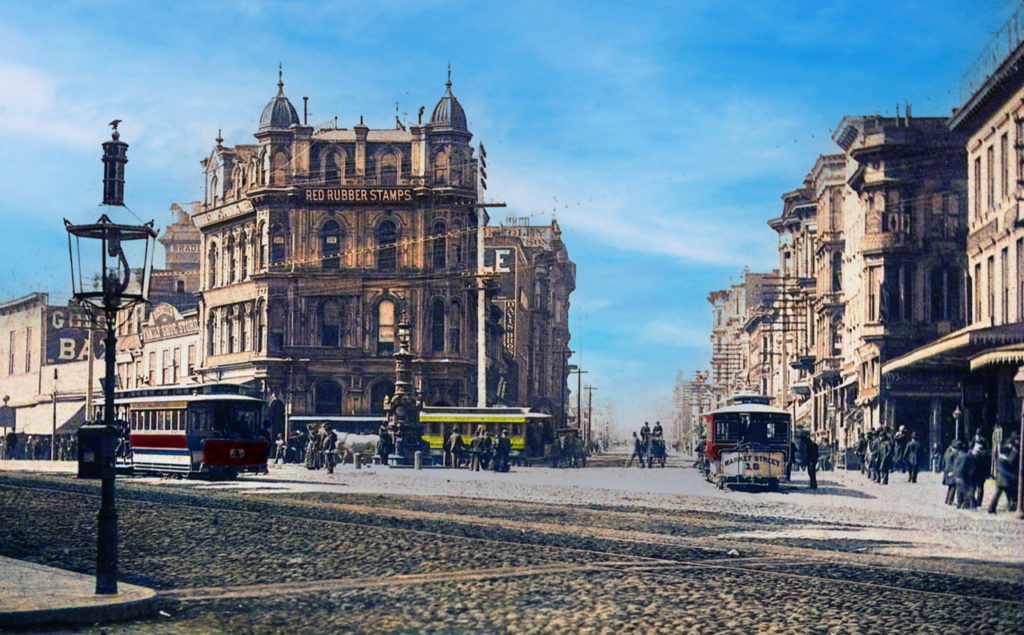
At the same time, Hallidie was getting close-by competition, just two blocks south of his Clay line, on wide California Street. Railroad magnate Leland Stanford (governor, senator, founder of a university named for his son) hooked up with associates from the powerful Central Pacific Railroad to promote and build a cable line initially running from Kearny to Fillmore Streets (soon extended east to Market and west to Presidio Avenue) and conveniently serving the Nob Hill mansions of Stanford and his partners. Hallidie objected to the line, claiming patent infringement. Stanford had to pay him $30,000 (worth 30 times that today).
Conquering curves
While technology details varied on these early cable lines, they shared one thing in common: they were straight. The technology allowed grips to drop the cable and coast around a downhill curve (while the underground cable wrapped around a big wheel, or sheave, to make the turn). Clever design also allowed grips to take the cable back after the curve. But curves on even gentle upslopes? The technology wasn’t advanced enough to handle them, greatly restricting where cable lines could be built.
That changed in 1881, when the challenge of navigating uphill curves while holding onto the cable was solved by George Duncan, in an unlikely place: Dunedin, New Zealand, with hills similar to San Francisco’s. (Dunedin was the last city other than San Francisco to operate street-running cable cars, until 1957.)
By designing the first “pull curve,” Duncan not only made the first cable line outside San Francisco possible, but triggered an intense but brief cable building boom in several countries. The first “pull curves” in San Francisco appeared on the Larkin Street line extension in 1883.
Conquering uphill curves opened the vault in terms of investment in cable technology. More than two dozen American cities quickly swapped horse cars for cable cars, despite the steep capital investment. Chicago was first in 1882, building a complex system incorporating new innovations by Asa Hovey. It demonstrated that cable cars worked in freezing, snowy weather as well as in San Francisco’s mild winters. The Chicago system was instantly profitable. The late economist and historian George Hilton notes, “The [Chicago] system replaced about 1,000 horses and 200 stablemen with only some 400 horsepower from the [stationary steam engine at the] powerhouse. Within two years, 150 to 180 cable cars were running on lines which had been served by 60 horsecars, and within five years, the company was reportedly hauling 27 million cable car passengers a year. Stock in the firm went from 100 to 300.”
Investors in New York, Philadelphia, Los Angeles, Washington, Seattle and other cities were all soon gripped by the cable bug. Overseas, they were joined by systems in London, Paris, Edinburgh, Glasgow, Sydney, and Melbourne, among other cities.
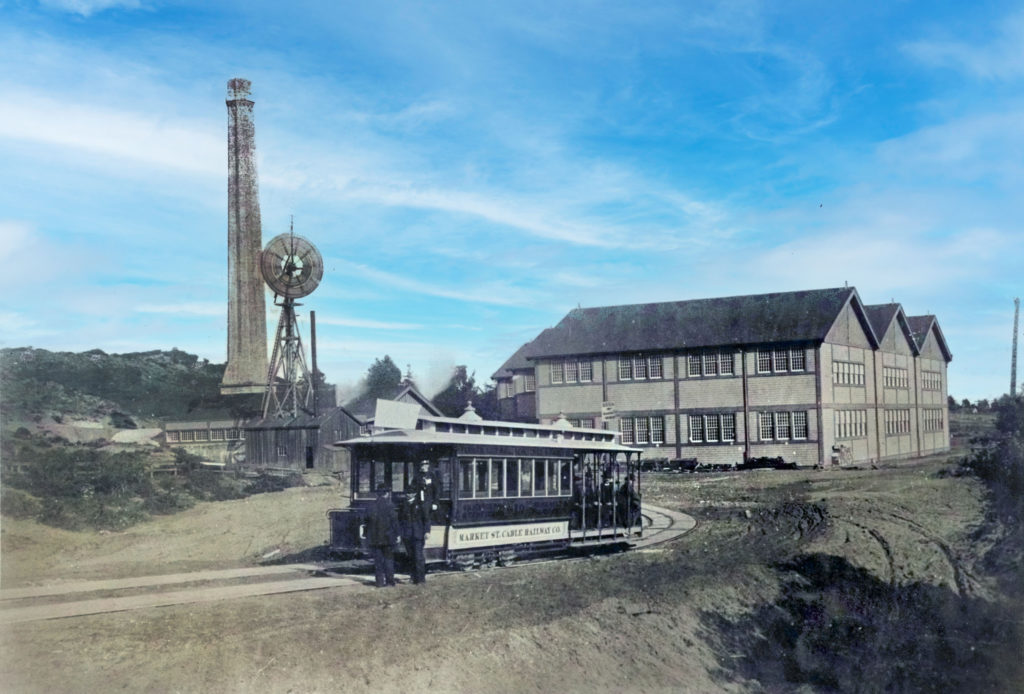
Cable’s zenith
In San Francisco, too, invention of the pull curve led to an eruption of new cable lines. The most impressive installation was the five-line system on Market Street, first opened in 1883. Starting at the Ferry Building, cable cars radiated deep into what was then suburbia, branching westward along McAllister, Hayes, and Haight Streets (all three lines reaching Golden Gate Park), south on Valencia to the edge of Bernal Heights, and south on Castro, climbing the steep hill between Eureka Valley and Noe Valley (the Castro Street part of this line survived until 1941). On the outer ends of all these lines, houses and businesses quickly sprang up.
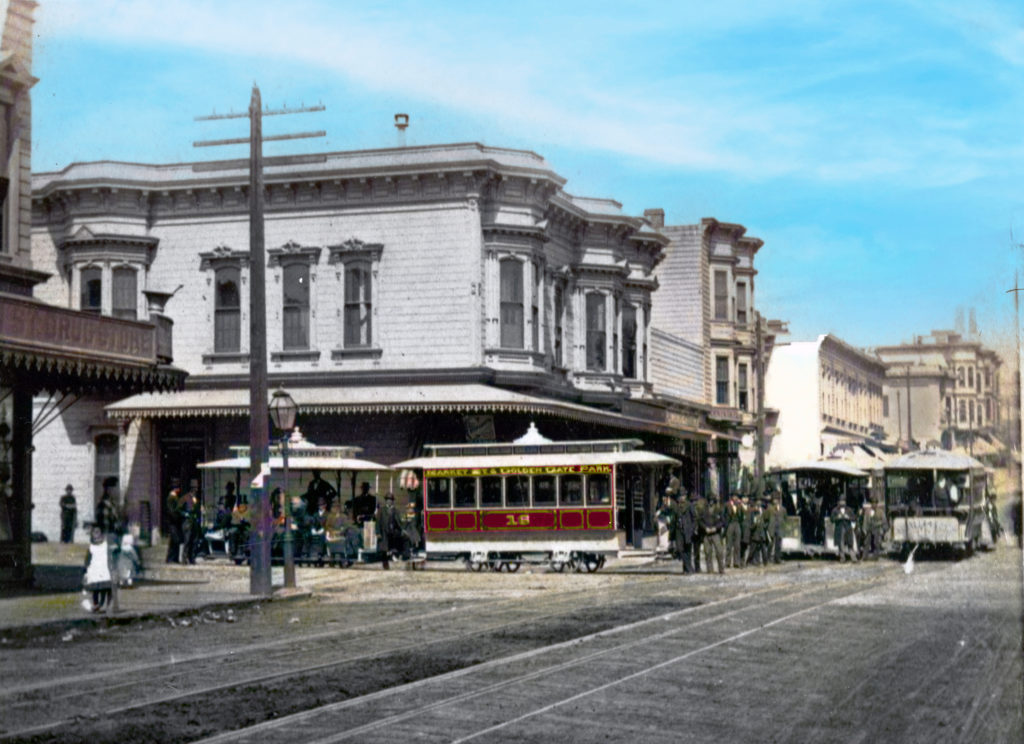
Additional cable lines followed later in the 1880s on Howard, and on Powell, Mason, Washington, Jackson and other streets. The company that built the Powell lines, Ferries & Cliff House Railway, also bought Hallidie’s original line on Clay Street, already out of date technologically, and rebuilt it to run one way on Clay, the other on Sacramento between the Ferry Building and, ultimately, Golden Gate Park. They bought a batch of new cable cars in 1894 to serve the Midwinter Fair in the Park via that Sacramento-Clay line. Many of those very cable cars still run on Powell Street today.
The last new cable line to be built in San Francisco opened in 1891, built by the California Street Cable Railroad Company to take advantage of its new powerhouse and carbarn at California and Hyde Streets. From that powerhouse, the line went north on Hyde to the then-industrial shoreline at Beach Street, where Domingo Ghirardelli soon built a chocolate factory, whose employees counted on the cable cars to get to work. In the other direction from the powerhouse, the line jogged onto Pine Street, then down Nob Hill on Jones Street through the Tenderloin District to O’Farrell Street, where it turned east and passed a block south of Union Square to terminate at Market.
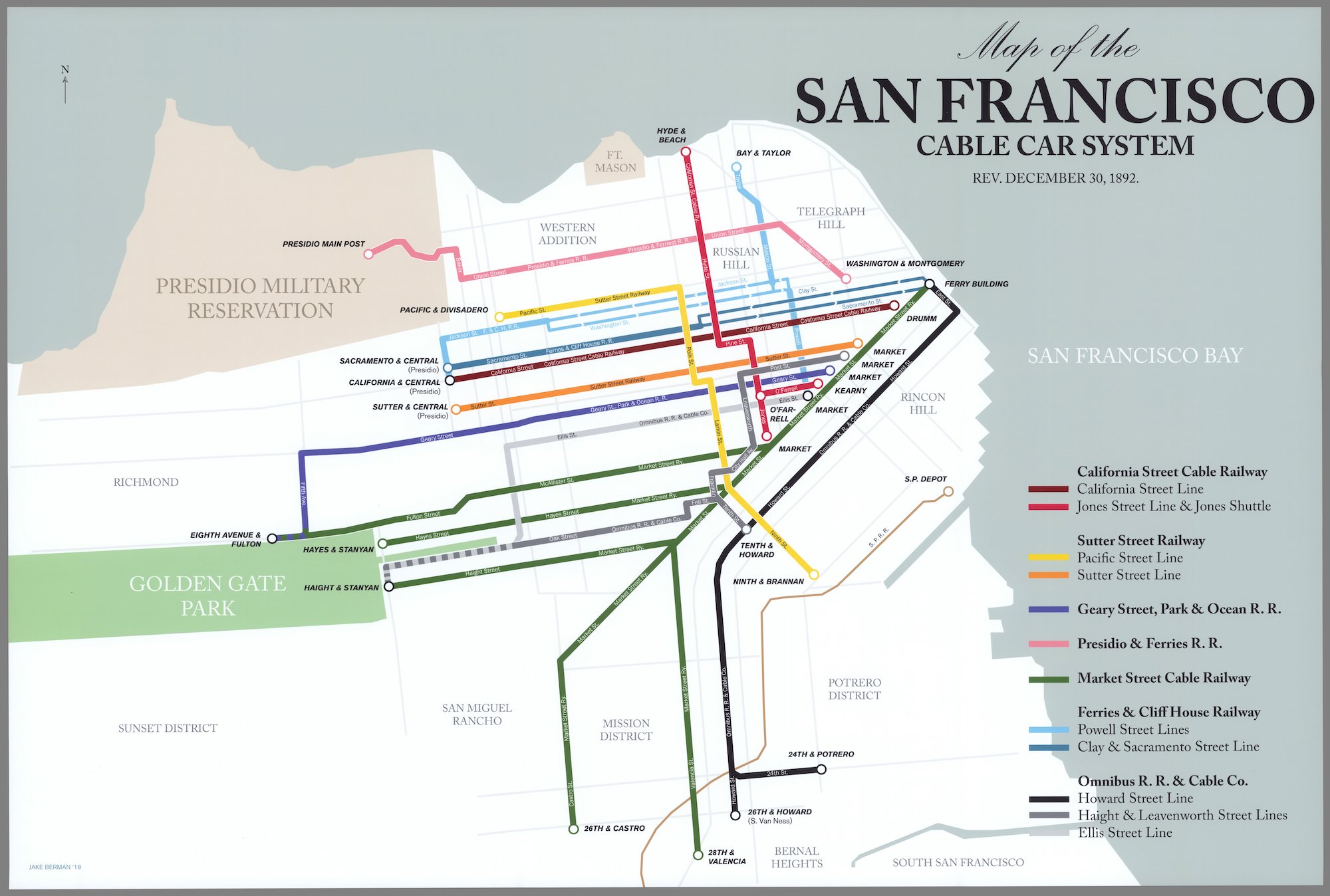
That O’Farrell, Jones & Hyde line closed in 1954, with the Hyde portion grafted onto the shortened Powell/Washington-Jackson line three years later. But as a new line in 1891, it showed the limitations of cable technology when many lines crossed each other within a city. When a new line opened, it had to run its cable beneath any existing cable lines where they crossed. That required a gripman on the new line to let go of the cable and coast across those crossings, lest they damage the cable of the “superior line”. The O’Farrell, Jones & Hyde line crossed so many older cable lines that gripmen had to drop, then retake, the “rope” 22 times every round trip. It was exhausting, and slowed down the trips.
Electric shock
The lines on Powell and Hyde were too steep for anything but cable traction, but most of the 350 miles of cable car lines installed around the world by 1891 were vulnerable to the next big thing in urban transport technology. And in short order, the electric streetcar killed them off.
Watt’s steam engine still had one more killer app to be launched: electric power. In 1882, Thomas Edison opened the first commercial electric central power plant, in lower Manhattan. Coal-fired steam engines turned Edison’s dynamos, which generated electricity sent through wires to light businesses nearby. If electricity sent through wires could power lights, it could also power motors, including those under the floor of a rail vehicle.
Inventors were already trying to power rail vehicles with electricity, but early attempts using rudimentary batteries fell short, as did the use of overhead wire due to the difficulty ofobtaining a good connection between the car and the overhead. The spring-tensioned trolley pole addressed the overhead issue.
On February 2, 1888, two months before San Francisco’s Powell Street cable lines opened, Frank J. Sprague launched the first practical electric streetcar operation, in Richmond, Virginia. Like Hallidie’s first cable line fifteen years before, parts of the technology had shortcomings, but as with cable technology, other innovators quickly overcame them.
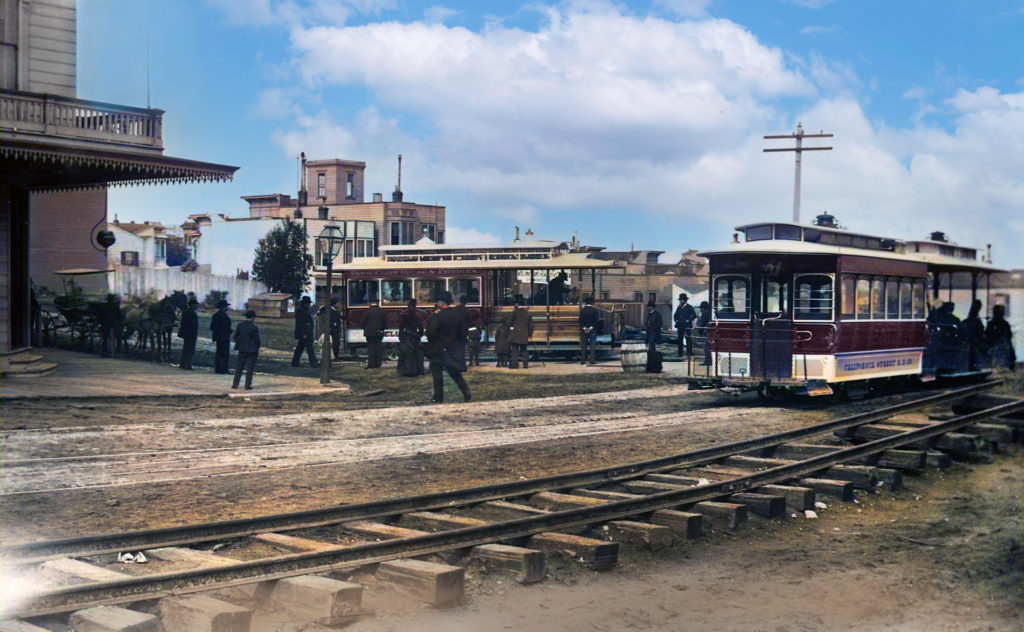
You might say if the cable car was a Blackberry, the electric streetcar was an iPhone: both revolutionary at their inception, but the newer technology had much broader capabilities and fewer inherent limitations than its predecessor. Mechanically latching onto and releasing a cable limited practical speeds in busy city centers. And it took time for horses, their riders, and pedestrians to get used to these fast machines sharing their streets. For this reason, San Francisco initially limited cable speeds to eight miles per hour by city ordinance. (It’s now a “speedy” 9.5 mph on the surviving lines.)
Where cable cars were extended into empty suburbs, they could safely run somewhat faster on the outer portions of lines: up to twelve mph on the outer end of the California Street cable line, and fourteen mph in suburban Chicago, for instance. But these speeds were no match for electric streetcars, which could operate much faster on city streets, and outside city limits, faster yet (some interurban electric lines in the Midwest routinely operated at 60 mph or more). Electric traction motors quickly developed the capacity to power city streetcars with twice as many passengers as most cable cars, and to haul multiple car trains between cities.
San Francisco got its first electric streetcar line in 1892, starting on Steuart Street near the waterfront (coincidentally, right next to today’s San Francisco Railway Museum) and running through the Mission District to reach Daly’s Hill at the southern border of the City, a distance impractical for a cable line. (By 1903, this electric line was extended south another thirteen miles to San Mateo.)
Installation costs for a Sprague electric streetcar line were about one-third of a new cable line. When added to the other advantages of electric streetcars, conversion was a no-brainer for transit companies around the world, which were all privately owned and profit-motivated at the time. The only exceptions were streets too steep for electric streetcars, or where political issues interfered.
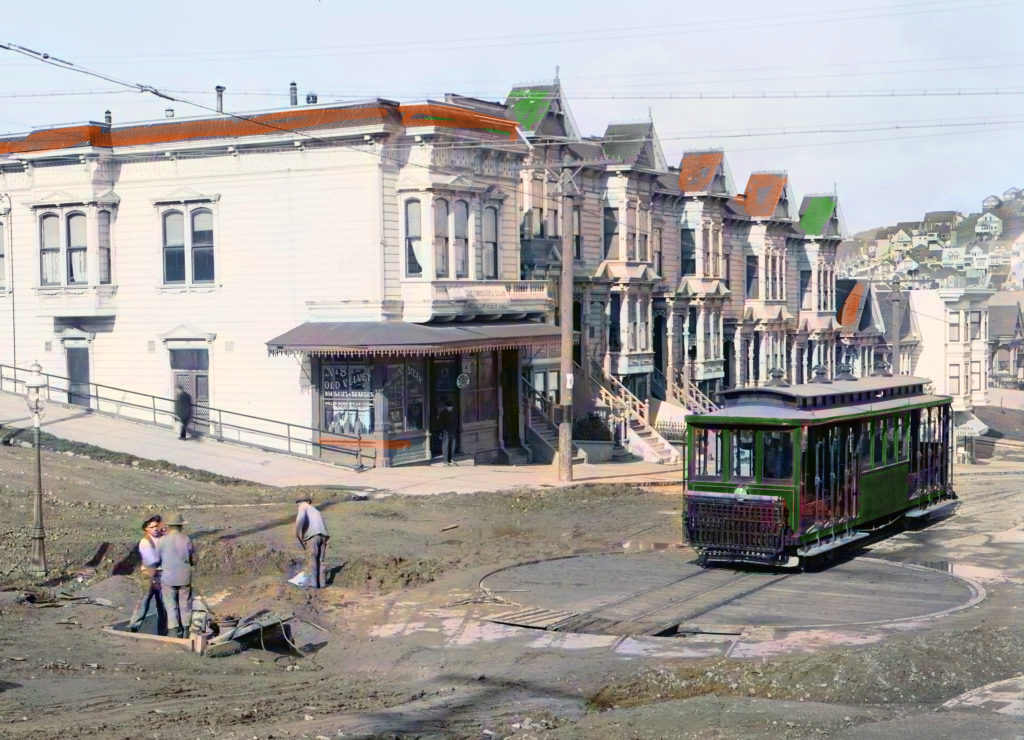
Overhead wires—both fear of electric shock and aesthetic concerns—were the most common political issue. For example, Congress prohibited overhead wires on Washington D.C.’s ceremonial boulevard, Pennsylvania Avenue. Similar restrictions existed in Manhattan. An 1895 technology development allowed the electric wires to be safely placed underground, like the cable was in the cable slot, and both cities soon converted. But converting cable car conduits to deeper electric conduits was more expensive than stringing overhead electric wires. The owners of San Francisco’s Market Street cable lines didn’t want to spend that much money. At the same time, civic activists successfully blocked overhead wires on Market Street on aesthetic grounds, even as they were quickly strung elsewhere in downtown and beyond. By early 1906, Market Street looked like an anachronism compared to most other large American cities now sporting the quick electric streetcars.
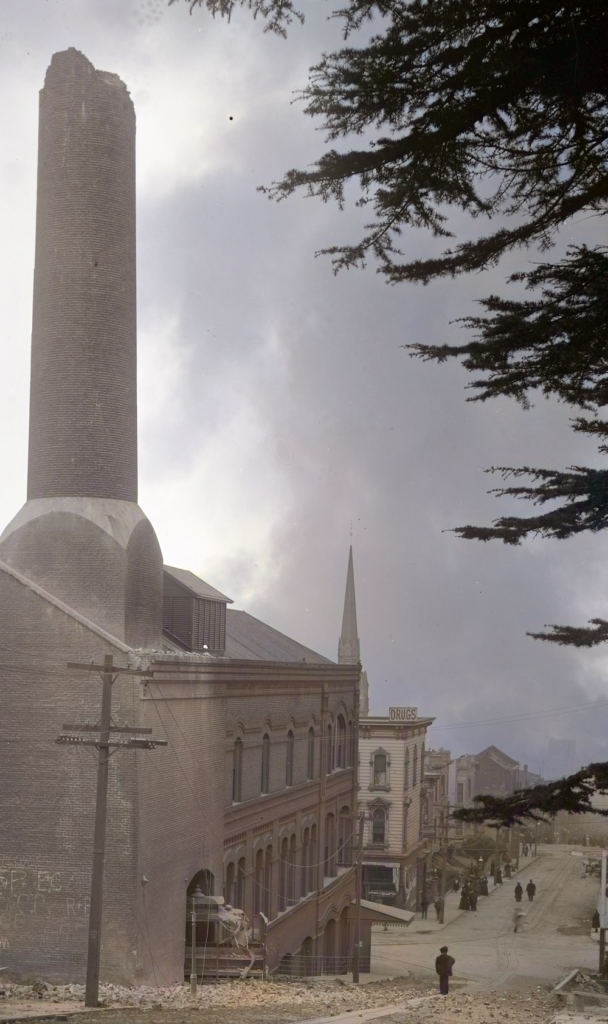
Shake up
That changed with a giant jolt on April 18, 1906 when a huge earthquake devastated much of the cable infrastructure in San Francisco and the subsequent fire incinerated more of it. The main transit company, United Railroads, won the right to string “temporary” wires above Market Street (made permanent through bribery of the mayor and the entire Board of Supervisors). San Francisco became a streetcar city, and remained so until mid-century.
The remaining cable-powered transit lines gradually disappeared in San Francisco and elsewhere, most done in by the development of internal combustion engines to the point where they could power motor buses up hills. The cable lines that remain today traded in their stationary steam engines a century ago for big winding motors, fed just like streetcars by central electric stations.
Cable technology—the “next big thing” of the 1870s—had become the “last big thing” in less than twenty years. Since 1957, street-running cable cars have been an “only in San Francisco” thing, climbing reliably “halfway to the stars” even as innovators in the city and Bay Area launched new generations of revolutionary technologies.
And while San Francisco’s cable technology remains 19th century in design, the system isn’t immune to modern touches. The hundreds of steel pulleys guiding the cables under the streets are now coated in Teflon to reduce friction, for example. And the cable cars themselves, originally lighted by dangerous kerosene lanterns hung from the ceiling (later supplanted by battery-powered incandescent lighting), now sport LED lighting that lessens the drain on the onboard battery. That freed-up battery capacity allows the cable cars to carry up to a half-dozen security cameras and satellite GPS as well.
Technology marches on!
By Rick Laubscher, Market Street Railway President
Hold your horses
Ask Americans today to share their image of horses in the 19th century, and most will paint a picture shaped by movies and television show of riders galloping freely through the Old West. But in the 1870s, most American horses lived in big cities, where their presence was often more offensive than romantic. In his definitive 1971 history, The Cable Car in America, Prof. George W. Hilton, to whom the author of this article is indebted, sheds light on why cities, and transit investors, were so anxious to find a technology that could replace horse-drawn streetcars.
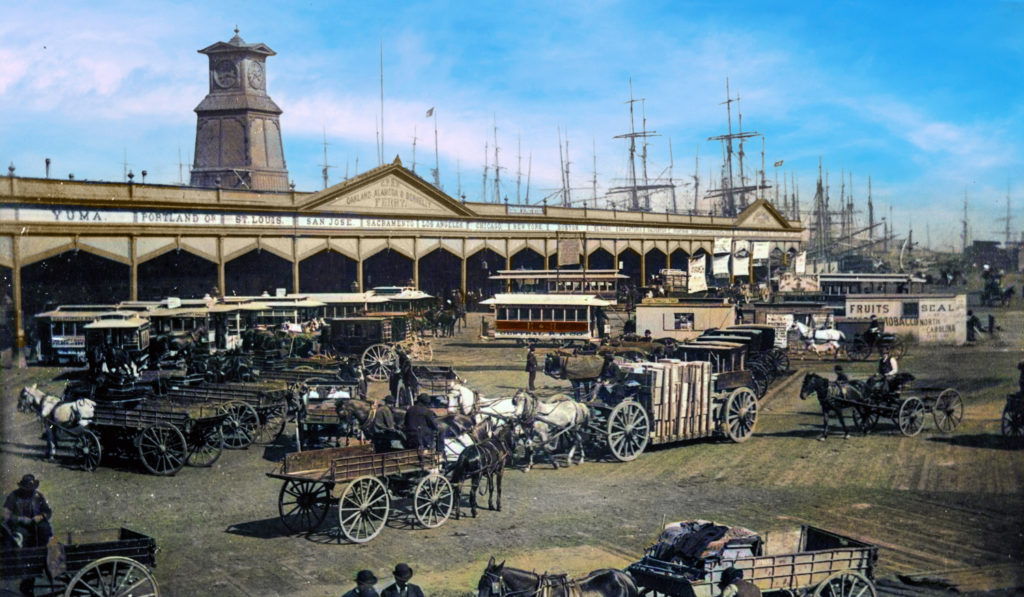
Excerpts
“The horsecar was unquestionably an improvement in speed and dependability over the horse-drawn omnibus, but its shortcomings were increasingly apparent as American urbanization progressed. Horse traction was capable of about 4 to 6 miles per hour, barely faster than walking, with a standard of comfort which was a continual source of complaint in the press. A car horse cost about $125 to $200 and was good for an average of four years of service before he had to be sold for less difficult duties. In the interim he was likely to have lost most of his value…operators [needed] from four to ten times as many horses as cars. Thus, a major street railway necessarily had much of its investment in horses, an asset which depreciated rapidly and was subject to decimation from disease [which happened in 1872 and intensified the desire of operators to find an alternative to horses].
“[C]ity governments had a strong incentive to urge replacement of [horse-drawn] street railways. A horse dropped over ten pounds of fecal material on the street and periodically drenched the pavement with urine. Not only was this offensive per se, but the feces contained the virus of tetanus, such that any skin abrasion on the streets entailed the risk of an absolutely fatal disease. Urination was so frequent that smooth pavements such as asphalt were not practical; either dirt or cobblestones had to be provided to assure traction between a horse’s hooves and the street. All forms of economic activities yield external benefits and involve social costs, but the social costs of horse traction were the most offensive in the history of transportation.”
If you like our exclusive content, please consider even a small donation to help our nonprofit.
In the 1830’s Pennsylvania’s Main Line of Public Works was a rail-canal system to move passengers and freight between Philadelphia and Pittsburgh. There were inclined planes at Belmont (Philadelphia) and Columbia as well as 10 planes between Hollidaysburg and Johnstown. Tese all used ropes and stationary steam engines to move railcars where grades were too steep for horse and there was not enough water for canal movement.
This is a tremendous article, you hit so many time points in the history of this iconic part of our history in San Francisco thank you., I feel like going out and taking a ride………….
Yes, it was a well prepared and researched article.
Excellent article. The detail of crossing lines and how that technical problem was solved and how it added to the grip man’s exhaustion is really interesting. Now I would write today about extending the California line from Van Ness to at least Fillmore – in my opinion and as it has been stated by others would appeal to tourists, enhance transportation alternatives to the Fillmore, and boost commerce in the lower Pacific Heights commercial district. We need to restore in part the original California line to the Fillmore!